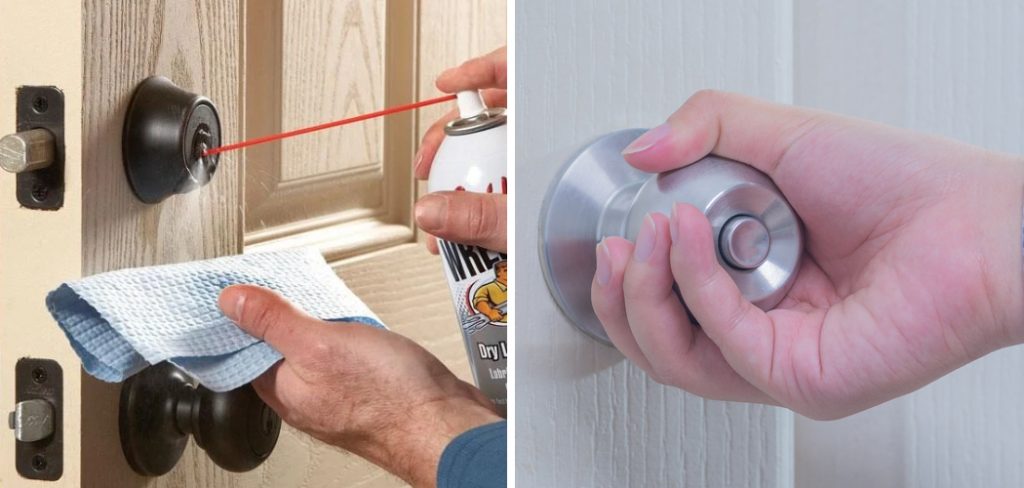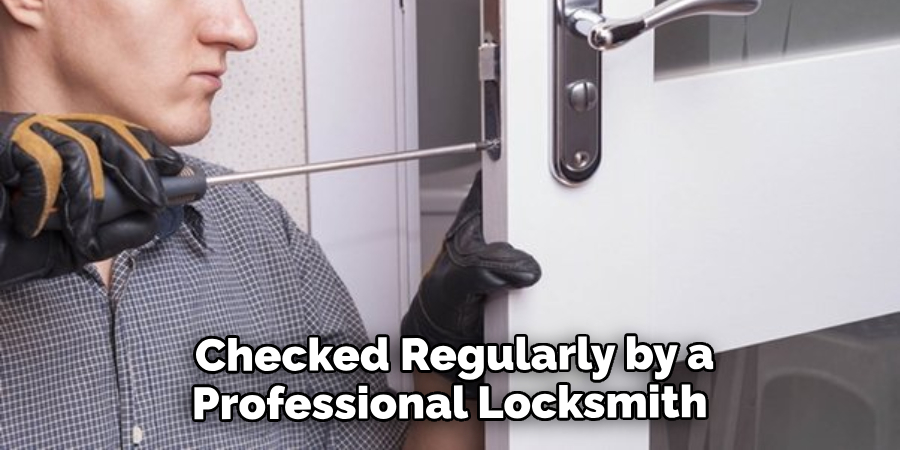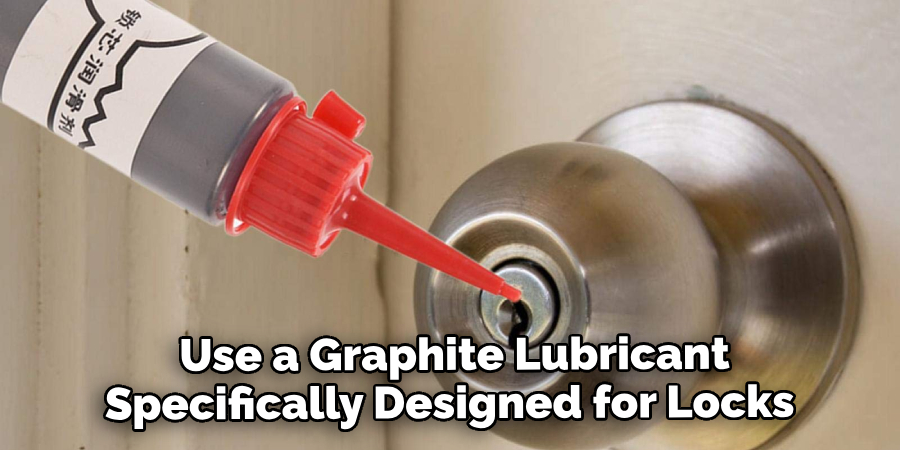Are you frustrated because your deadbolt is stuck in the locked position? Maybe it won’t open when you insert your key or turn it, no matter which way. Or perhaps it appears like it should unlock but just won’t budge?
You can breathe easy knowing that you don’t have to rip out the door frame or call a locksmith to get into these kinds of predicaments; instead, some simple steps will help solve this common issue with minimal effort and cost. Read on for our tried-and-true tips on how to fix deadbolt stuck in locked position.

Necessary Items
Before we dive into the steps, you will need a few items to attempt to fix your stuck deadbolt. These include:
- A screwdriver (usually Phillips-head)
- Graphite lubricant or WD-40
- Rag or paper towel for cleaning
- A hairdryer (optional)
10 Steps on How to Fix Deadbolt Stuck in Locked Position
Step 1: Inspect Your Key and Lock the Cylinder
The first thing you should do is inspect your key for any visible damage or wear. Check to ensure there are no missing teeth or bends that could prevent it from turning correctly in the lock cylinder. Next, examine the lock cylinder for any debris or buildup causing a blockage. If you find any, use your rag or paper towel to clean it out.
Step 2: Lubricate the Key and Lock
If your key and lock are both in good condition, the next step is to lubricate them. You can use either graphite lubricant or WD-40 for this task. Spray a small amount of lubricant into the keyhole, then insert your key and turn it several times to distribute the lubricant evenly. This will help loosen any stuck components inside the lock.
Step 3: Try Jiggling the Key
Sometimes, a simple jiggling motion can help dislodge any stuck parts in the lock. While inserting your key, try wiggling it gently back and forth to see if that helps loosen things up.
Step 4: Use a Hairdryer on Low Heat
If your deadbolt is stuck due to cold weather or frozen parts, you can use a hairdryer on low heat to warm up the lock and key. This will help melt any ice or frost that may prevent the lock from turning.

Step 5: Check the Deadbolt Alignment
A common cause of a stuck deadbolt is misalignment with the strike plate. This can happen over time due to wear and tear on the door frame or the house’s settling. To check the alignment, close the door and see if there are any gaps between the deadbolt and the strike plate. If there are, you must adjust the strike plate by loosening its screws and moving it slightly until it aligns with the deadbolt.
Step 6: Tighten Loose Screws
If your deadbolt is loose, it can also cause it to get stuck in the locked position. Check for any loose screws and tighten them with a screwdriver if needed.
Step 7: Use a Key Extractor
If your key is broken off inside the lock or you cannot remove it, you may need to use a key extractor tool. This tool is designed to remove broken lock keys and can be purchased at most hardware stores. Follow the instructions on the key extractor carefully to avoid causing any further damage to your lock.
Step 8: Tap the Key with a Hammer
If your key doesn’t turn in the lock, it could be due to a stuck pin or tumbler inside the lock cylinder. To dislodge it, tap the key gently with a hammer while turning it in the lock. Be careful not to use too much force, which could damage your key or lock.

Step 9: Apply Pressure While Turning
If none of the previous steps have worked, apply pressure to the key while turning it in the lock. This can help push any stuck components out of the way and allow the key to turn. Again, be gentle with this method to avoid causing damage.
Step 10: Call a Professional
If you have exhausted all other options and your deadbolt is still locked, it may be time to call a professional locksmith. They have the tools and expertise to safely and effectively fix your stuck deadbolt without causing any further damage.
8 Tips on Preventing a Stuck Deadbolt in the Future
Now that you have successfully fixed your stuck deadbolt, preventing it from happening again is important. Some tips for preventing a stuck deadbolt include:
1. Keep Your Key and Lock Clean
Regularly clean your key and lock to prevent any buildup or debris from causing a blockage. Use a graphite lubricant to keep your lock mechanism running smoothly.
2. Avoid Harsh Weather Conditions
Extreme temperatures and freezing weather can cause your lock to freeze and get stuck. Avoid using your deadbolt in these conditions or use preventative measures such as silicone spray on the key and inside the lock.
3. Don’t Force Your Key
If your key won’t turn, don’t force it, as this can damage both the key and lock. Instead, try using some earlier methods to loosen any stuck components.
4. Get Your Lock Checked Regularly
Just like any other mechanical device, locks can wear out over time. Getting your deadbolt checked regularly by a professional locksmith can help identify any issues before they become bigger problems.

5. Use High-Quality Keys and Locks
Investing in high-quality keys and locks can save you from dealing with stuck deadbolts in the future. These are less likely to break or get stuck than cheaper, lower-quality options.
6. Check for Loose Screws
Loose screws can cause your deadbolt to malfunction, so checking them regularly and tightening them as needed is important.
7. Fix Misalignment Issues Promptly
If you notice your deadbolt is not aligning properly with the strike plate, address the issue right away to prevent further wear and tear on the lock.
8. Don’t Ignore Minor Issues
If you notice any minor issues with your deadbolt, such as difficulty turning the key or a loose lock, don’t ignore them. These could be signs of a bigger problem leading to a stuck deadbolt if left unchecked.
By following these tips and taking good care of your deadbolt, you can prevent it from getting stuck and ensure it continues functioning properly for years. Remember, if you encounter any issues, it’s best to address them promptly and seek professional help. So, regular maintenance is important to keep your deadbolt functioning smoothly and avoid any potential problems in the future.
Frequently Asked Question
How Do I Know if My Deadbolt is Stuck or Just Needs Lubrication?
If your key doesn’t turn in the lock, it could indicate a stuck deadbolt. However, before assuming that, try adding some lubricant to see if that helps loosen things up. If your key still won’t turn, it is likely a stuck deadbolt.
Can I Fix a Stuck Deadbolt Myself?
Sometimes, you can fix a stuck deadbolt by following the above steps. However, if you are uncomfortable or unsure about the process, it’s best to call a professional locksmith for assistance. Trying to fix a stuck deadbolt without proper knowledge and tools can cause further damage and may cost you more in the long run.
How Often Should I Get My Deadbolt Checked?
It is recommended to get your deadbolt checked at least once a year by a professional locksmith. This will help identify any potential issues before they become bigger problems that can result in a stuck deadbolt.
What Type of Lubricant Should I Use on My Deadbolt?
It is best to use a graphite lubricant specifically designed for locks. Avoid using oil-based lubricants as they can attract dirt and debris, which can cause more problems in the long run.

Conclusion
Dealing with a stuck deadbolt can be frustrating, but this guide has provided helpful tips and solutions for fixing the issue. Homeowners should now feel equipped to attempt to fix their stuck deadbolt locks. If any of the suggested methods still fail to address the problem adequately, they likely have an issue with their deadbolt mechanism that needs attention from a specialist.
Be sure to find someone trustworthy and experienced in working with locks, as this can help prevent any further mishaps or complications in the future. Taking care of these issues early on can help save you time, effort, and money. When protecting your home, never settle for anything less than the best; ensure that your home’s security solution gets the maintenance and proper care it needs.
Ultimately, locking yourself out of a room may seem inconvenient at the moment – but thankfully, there are many steps you can take if you ever find yourself in such a situation again! Remember always to handle your deadbolt with care, perform regular maintenance, and seek professional help if needed to ensure it continues to function properly in the future.
Always prioritize safety and avoid using excessive force when fixing a stuck deadbolt, which can cause further damage. With proper care and attention, your deadbolt should continue to serve as a reliable and secure lock for your home or business. So, keep these tips on how to fix deadbolt stuck in locked position in mind, and don’t let a stuck deadbolt ruin your day!
About
Safety Fic is a distinguished figure in the world of Diy design, with a decade of expertise creating innovative and sustainable Diy solutions. His professional focus lies in merging traditional craftsmanship with modern manufacturing techniques, fostering designs that are both practical and environmentally conscious. As the author of diy, Safety Fic delves into the art and science of Safety Fic-making, inspiring artisans and industry professionals alike.
Education RMIT University
(Melbourne, Australia) Associate Degree in Design (Safety Fic) Focus on sustainable design, industry-driven projects, and practical craftsmanship. Gained hands-on experience with traditional and digital manufacturing tools, such as CAD and CNC software.
Nottingham Trent University
(United Kingdom) Bachelor’s in diyfastly.com and Product Design (Honors) Specialized in product design with a focus on blending creativity with production techniques. Participated in industry projects, working with companies like John Lewis and Vitsoe to gain real-world insights.
Publications and Impact
In diy, Safety Fic his insights on indoor design processes, materials, and strategies for efficient production. His writing bridges the gap between artisan knowledge and modern industry needs, making it a must-read for both budding designers and seasoned professionals.
